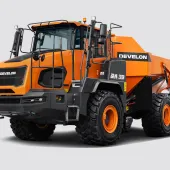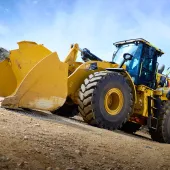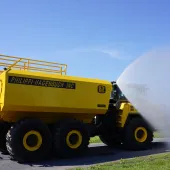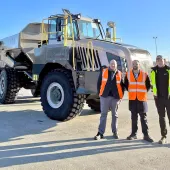Caterpillar introduce new off-highway trucks
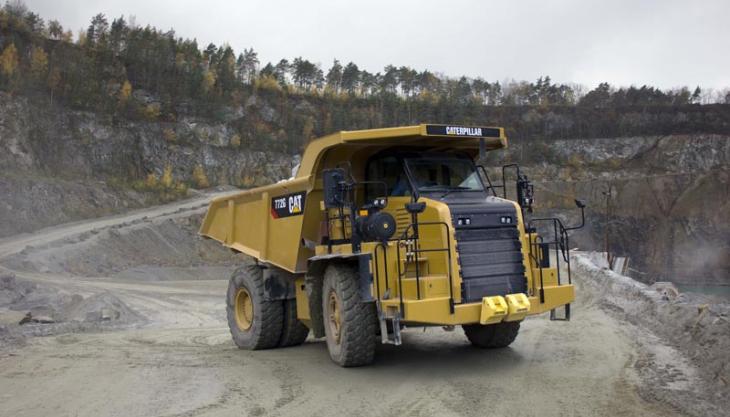
Latest Cat 770G and 772G trucks offer refined performance, improved fuel-efficiency and easier serviceability
ACCORDING to Caterpillar, the new 770G and 772G off-highway trucks have been designed with major advancements in emissions technology, transmission and traction control systems; frame, drivetrain and cooling system enhancements; and serviceability improvements. In addition, many of the key features on the larger Cat G-Series off-highway trucks have been incorporated on the new models.
With nominal rated payload capacities of 40 and 52 tonnes, respectively, the new 770G truck is powered by a Cat C15 engine (477hp) while the 772G model is equipped with a Cat C18 engine (550hp).
Available in Tier 2/Stage II, Tier 3/Stage III, and Tier 4 Final/Stage IV configurations, the engines can be programmed to achieve the customer's specific fuel economy goals.
Two programmable modes are available: Economy and Adaptive Economy. The former allows the customer to select a derate value between 0.5% and 15%. At the touch of a button, steady power deration is provided across all portions of the haul cycle.
In Adaptive Economy mode, the truck monitors power demand, delivering fuel savings when possible and horsepower when needed, to optimize fuel economy throughout the haul cycle.
For further fuel savings, a new Auto Neutral Idle feature automatically places the transmission in neutral gear after the brake is applied for more than 15s while in a forward gear. This, say Caterpillar, reduces parasitic drive-train loads and provides major fuel-efficiency improvements.
Once an operator removes their foot from the brake, the transmission re-engages. This is completely transparent to the operator. Also, a hydraulically driven, on-demand cooling fan reduces power draw on the engine by operating only when required and at the speed required.
The new transmission control system – Advanced Productivity Electronic Control Strategy (APECS) – provides a number of benefits, including improved shift quality, faster acceleration, better speed on grade and faster cycle times.
This new control strategy modulates shift points to match optimum operating speed and torque; minimizes torque spikes during shifts; reduces stress on the drive train, which increases drive train component life; provides greater operator comfort and control; and reduces material spillage.
An optional advanced traction control system uses the service brakes instead of the park brake components to modulate wheel slip. This change in design makes the system much more responsive to traction loss in the lower speed ranges, and improves speed on grade in wet, slippery conditions.
The traction control system also assesses front wheel steering angle when determining traction slippage and adjusts the degree of allowance in wheel-speed differential that naturally increases between the inside and outside wheels when the machine is turning.
By assessing steering angle, it compensates for the outside wheel turning at a higher speed to improve traction. Wheel stations feature a one-piece wheel-and-hub design that simplifies servicing and reduces leak potential. The single-piece design reduces removal and installation time and the risk of brake cooling oil leakage.
Frame designs for the 770G and 772G have been modified to more precisely balance weight and durability requirements, providing frames tailored to the truck's payload capacity, while maintaining the robust service life customers expect from Cat frames.
The 770G and 772G also have a new four post ROPS/FOPS structure that is integral with the cab. The centre cab position provides ample interior room and creates a walk-in style cab, allowing the operator to easily enter and exit.
The cab is resiliently mounted to the frame to dampen sound and vibration, and with the new Cat Series III Optimized Seat System, the 770G and 772G provide the operator support and comfort throughout the day with long-term durability.
Operator safety is enhanced with handrails, lighting and a low-effort stair step system using a star pattern tread plate on the walkways, allowing the operator to safely get on and off of the truck. A new rear hinged door provides immediate accessibility to the cab, and new handrails on the ROPS posts facilitate safely cleaning the front windshield.
The latest off-highway trucks include as standard a number of information systems such as VIMS 3G Vital Information Management System; Truck Production Management System (TPMS); TMPH (ton mile per hour)/TKPH (tonne kilometer per hour) tyre management system; and product link (standard or mobile).
In terms of serviceability, all routine service points are accessible from secure platforms or from ground-level access, enhancing technician safety. Three spin-on fuel filters ensure fuel cleanliness, and the primary fuel filter incorporates a water separator and an electric priming pump.
Filters in the steering, braking, and transmission/torque converter circuits are sized to provide 1,000h service intervals, while a brake-wear indicator on the rear wheel groups is a standard feature. The new machines also feature a warning system that alerts the operator when tyre capacity limitations are exceeded. An in-cab, fluid-monitoring system is available.
In addition, the Cat ET (Electronic Technician) service tool provides access to stored diagnostic data through the Cat Data Link, including the status of all engine parameters (throttle position, speed, timing, and fuel flow/consumption), as well as data from transmission controls, including gear selection and shift times.



